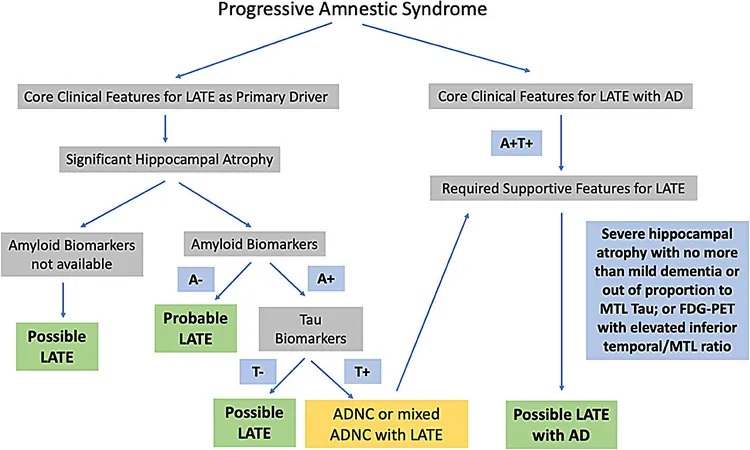
Groundbreaking New Criteria for LATE Dementia Promise Enhanced Patient Care and Treatment Options
2025-01-17
Author: Li
Significant Leap in Dementia Research
In a significant leap forward in dementia research, scientists at the University of Kentucky's Sanders-Brown Center on Aging have unveiled new clinical diagnostic criteria for a condition known as LATE, or "limbic predominant age-related TDP-43 encephalopathy." This innovative research is proving crucial for the over one-third of individuals aged 85 and older who are affected by LATE, which often erroneously presents itself as Alzheimer's disease, leading to substantial memory loss and cognitive decline.
Revolutionizing Diagnosis and Treatment
Recently published in the esteemed journal *Alzheimer's & Dementia*, these new diagnostic guidelines aim to revolutionize how patients are diagnosed and treated, thus accelerating the development of targeted therapies. Dr. Pete Nelson, a renowned neuropathologist and chair of Alzheimer's Disease at the University of Kentucky, emphasizes the urgency of recognizing LATE as a distinct condition that, while similar to Alzheimer's, necessitates different care strategies.
A Monumental Advancement
"These guidelines are a monumental advancement in our ability to differentiate LATE from Alzheimer's, ensuring that patients receive the most suitable treatments," states Nelson. The collaborative efforts of an international panel of experts, including Dr. Nelson and Dr. Greg Jicha, have made this crucial distinction possible, establishing a framework that will greatly benefit both clinicians and researchers in identifying LATE in patients.
Pivotal Role of the Sanders-Brown Center
The Sanders-Brown Center is notably the site of the world’s sole clinical trial focused on LATE, led by Dr. Jicha, signifying the University of Kentucky's pivotal role in this frontier of dementia research. “This initiative highlights how vital precise dementia diagnostics are,” Jicha remarks. The implementation of the new criteria not only fills a glaring gap in the identification of LATE but also empowers healthcare providers to deliver more accurate and effective care.
Characteristics and Diagnostic Techniques
Memory loss coupled with hippocampal atrophy—the reduction of the brain's memory center—are characteristic signs of LATE. The newly established guidelines detail how imaging technologies and other diagnostic techniques can aid in differentiating LATE from Alzheimer's and various other dementia types. Nelson further explains, "These advancements are crucial not only in accurately diagnosing LATE but also in discerning its interactions with other neurological disorders, including Alzheimer's."
Impact on Treatment and Future Therapy
The diagnosis of LATE is intricately tied to the treatment of Alzheimer's, as misclassifications may prevent patients from accessing the most appropriate therapies tailored to their specific conditions. Recognizing LATE accurately will help not only in administering better immediate care but also in clearing the path for innovative therapies in the future.
Commitment to Advancing Research
This extraordinary research exemplifies the commitment of the Sanders-Brown Center to advance scientific understanding and application from the laboratory to real-world clinical settings.
Renewed Hope for Patients and Families
With these new diagnostic tools and frameworks, there is renewed hope for patients and their families grappling with dementia. Enhanced precision in identifying LATE might pave the way for improved patient outcomes and a brighter future for dementia research and treatment.
Stay Tuned for More Updates
Stay tuned for more updates as we continue to follow the advancements in this vital area of health research!



 Brasil (PT)
Brasil (PT)
 Canada (EN)
Canada (EN)
 Chile (ES)
Chile (ES)
 Česko (CS)
Česko (CS)
 대한민국 (KO)
대한민국 (KO)
 España (ES)
España (ES)
 France (FR)
France (FR)
 Hong Kong (EN)
Hong Kong (EN)
 Italia (IT)
Italia (IT)
 日本 (JA)
日本 (JA)
 Magyarország (HU)
Magyarország (HU)
 Norge (NO)
Norge (NO)
 Polska (PL)
Polska (PL)
 Schweiz (DE)
Schweiz (DE)
 Singapore (EN)
Singapore (EN)
 Sverige (SV)
Sverige (SV)
 Suomi (FI)
Suomi (FI)
 Türkiye (TR)
Türkiye (TR)